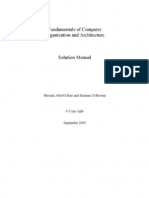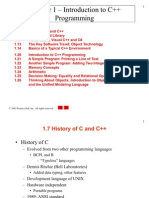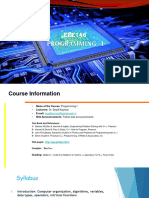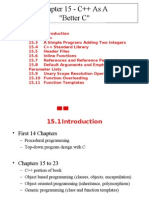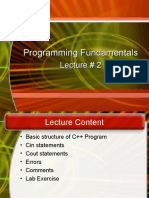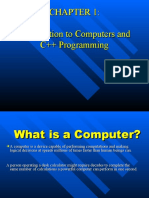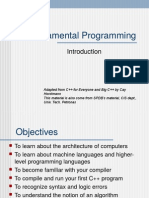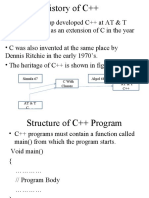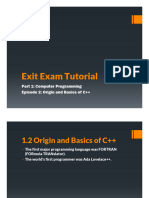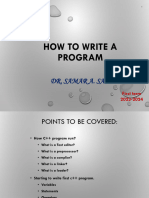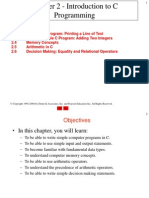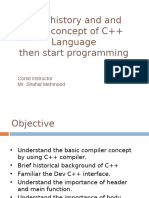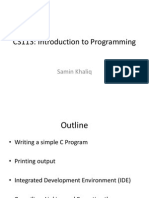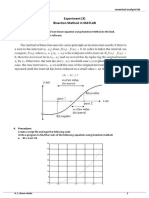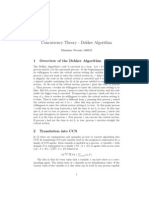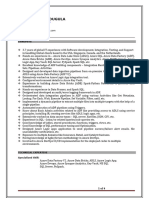in This Course You Will Learn: - C and C++ - Structured Programming and Object Oriented Programming
in This Course You Will Learn: - C and C++ - Structured Programming and Object Oriented Programming
Uploaded by
ana liaCopyright:
Available Formats
in This Course You Will Learn: - C and C++ - Structured Programming and Object Oriented Programming
in This Course You Will Learn: - C and C++ - Structured Programming and Object Oriented Programming
Uploaded by
ana liaOriginal Title
Copyright
Available Formats
Share this document
Did you find this document useful?
Is this content inappropriate?
Copyright:
Available Formats
in This Course You Will Learn: - C and C++ - Structured Programming and Object Oriented Programming
in This Course You Will Learn: - C and C++ - Structured Programming and Object Oriented Programming
Uploaded by
ana liaCopyright:
Available Formats
1
1.1 Introduction
In this course you will learn
C and C++ Structured programming and object oriented programming
2000 Prentice Hall, Inc. All rights reserved.
1.2
Computer
What is a Computer?
A device capable of performing computations and making logical decisions
Computer programs
Sets of instructions that control a computers processing of data
Hardware
Various devices comprising a computer
Examples: keyboard, screen, mouse, disks, memory, CDROM, and processing units
Software
Programs that run a computer
2000 Prentice Hall, Inc. All rights reserved.
1.3 Computer Organization
Six logical units in every computer:
Input unit
Obtains information from input devices (keyboard, mouse)
Output unit
Outputs information (to screen, to printer, to control other devices)
Memory unit
Rapid access, low capacity, stores input information
Arithmetic and logic unit (ALU)
Performs arithmetic calculations and logic decisions
Central processing unit (CPU)
Supervises and coordinates the other sections of the computer
Secondary storage unit
Cheap, long-term, high-capacity storage, stores inactive programs
2000 Prentice Hall, Inc. All rights reserved.
1.13 Basics of a Typical C++ Environment
Phases of C++ Programs: 1. Edit 2. Preprocess 3. Compile
Editor Disk
Program is created in the editor and stored on disk. Preprocessor program processes the code. Compiler creates object code and stores it on disk. Linker links the object code with the libraries, creates a.out and stores it on disk
Preprocessor
Disk
Compiler
Disk
Linker
Disk
Primary Memory
4. Link
5. Load
Loader
Loader puts program in memory.
Disk
. . . . . .
6. Execute
CPU
Primary Memory CPU takes each instruction and executes it, possibly storing new data values as the program executes.
2000 Prentice Hall, Inc. All rights reserved.
. . . . . .
1.14 Hardware Trends
Every year or two computers approximately double
The amount of memory they contain
Memory used to execute programs
The amount of secondary storage they contain
Secondary storage (such as disk storage) is used to to hold programs and data over time
Their processor speeds
The speed at which computers execute their programs
2000 Prentice Hall, Inc. All rights reserved.
1.15 History of the Internet
The Internet enables
Quick and easy communication via e-mail International networking of computers
Packet switching
Transfers digital data via small packets Allows multiple users to send and receive data simultaneously
No centralized control
If one part of the Internet fails, other parts can still operate
Bandwidth
Carrying capacity of communications lines
2000 Prentice Hall, Inc. All rights reserved.
1.16 History of the World Wide Web
World Wide Web
Allows users to locate and view multimedia-based documents on almost any subject Makes information instantly and conveniently accessible worldwide Makes it possible for individuals and small businesses to get worldwide exposure Is changing the way business is done
2000 Prentice Hall, Inc. All rights reserved.
1.17 General Notes About C++ and This Book Book is geared toward novice programmers Programming clarity is stressed C and C++ are portable languages
Programs written in C and C++ can run on many different computers
2000 Prentice Hall, Inc. All rights reserved.
1.18 Introduction to C++ Programming
C++ language
Facilitates a structured and disciplined approach to computer program design
Following are several examples
The examples illustrate many important features of C++ Each example is analyzed one statement at a time.
2000 Prentice Hall, Inc. All rights reserved.
1 2
// Fig. 1.2: fig01_02.cpp // A first program in C++
10
Outline
Comments 1. Comments Written between /* and */ or following a //. Improve program readability and do not cause the computer to perform any action. 2. Load <iostream> preprocessor directive 3. main
3 #include <iostream> 4 5 int main() 6 {
7 8 9 10 } return 0; std::cout << "Welcome to C++!\n";
Message to the C++ preprocessor. 3.1 Print "Welcome to C++\n" Lines beginning with # are preprocessor directives. #include <iostream> tells theexit preprocessor to 0) 3.2 (return include the contents ofone theor file <iostream> , which C++ programs contain more functions, one of includes input/output which must be main operations (such as printing to Program Output the screen). Parenthesis are used to indicate a function
// indicate that program ended successfully
Welcome to C++!
Prints the string of characters contained between the an integer value. int means that main "returns" quotation marks. More in Chapter 3. return is a way to exit a function from a function. A left brace { begins The entire line, including std::cout , the the << body of every function and a right to brace } ends it. and operator , the C++!\n" return 0, in this case, means thatstring "Welcome the semicolon (;), is called a statement. the program terminated normally. All statements must end with a semicolon.
2000 Prentice Hall, Inc. All rights reserved.
11
1.19 A Simple Program: Printing a Line of Text std::cout
Standard output stream object Connected to the screen std:: specifies the "namespace" which cout belongs to
std:: can be removed through the use of using statements
<<
Stream insertion operator Value to the right of the operator (right operand) inserted into output stream (which is connected to the screen) std::cout << Welcome to C++!\n;
\
Escape character Indicates that a special character is to be output
2000 Prentice Hall, Inc. All rights reserved.
12
1.19 A Simple Program: Printing a Line of Text
Escape Sequence \n \t \r Description Newline. Position the screen cursor to the beginning of the next line. Horizontal tab. Move the screen cursor to the next tab stop. Carriage return. Position the screen cursor to the beginning of the current line; do not advance to the next line. Alert. Sound the system bell. Backslash. Used to print a backslash character. Double quote. Used to print a double quote character.
\a \\ \"
There are multiple ways to print text
Following are more examples
2000 Prentice Hall, Inc. All rights reserved.
1 2 3
// Fig. 1.4: fig01_04.cpp // Printing a line with multiple statements #include <iostream>
13
Outline
1. Load <iostream> 2. main 2.1 Print "Welcome" 2.2 Print "to C++!" 2.3 newline 2.4 exit (return 0) Program Output
4
5 6 7 8 9 10 return 0; // indicate that program ended successfully int main() { std::cout << "Welcome "; std::cout << "to C++!\n";
11 }
Welcome to C++!
Unless new line '\n' is specified, the text continues on the same line.
2000 Prentice Hall, Inc. All rights reserved.
1 2 3 4 5 6 7 8 9
// Fig. 1.5: fig01_05.cpp // Printing multiple lines with a single statement #include <iostream>
14
Outline
1. Load <iostream> 2. main
int main() { std::cout << "Welcome\nto\n\nC++!\n";
2.1 Print "Welcome"
2.2 newline
2.3 Print "to"
return 0;
// indicate that program ended successfully
2.4 newline 2.5 newline 2.6 Print "C++!" 2.7 newline 2.8 exit (return 0)
10 }
Welcome to C++!
Multiple lines can be printed with one statement.
Program Output
2000 Prentice Hall, Inc. All rights reserved.
15
1.20 Another Simple Program: Adding Two Integers Variables
Location in memory where a value can be stored for use by a program Must be declared with a name and a data type before they can be used Some common data types are:
int - integer numbers char - characters double - floating point numbers
Example: int myvariable;
Declares a variable named myvariable of type int
Example: int variable1, variable2;
Declares two variables, each of type int
2000 Prentice Hall, Inc. All rights reserved.
16
1.20 Another Simple Program: Adding Two Integers >> (stream extraction operator)
When used with std::cin, waits for the user to input a value and stores the value in the variable to the right of the operator The user types a value, then presses the Enter (Return) key to send the data to the computer Example:
int myVariable; std::cin >> myVariable; Waits for user input, then stores input in myVariable
= (assignment operator)
Assigns value to a variable Binary operator (has two operands) Example:
sum = variable1 + variable2;
2000 Prentice Hall, Inc. All rights reserved.
1 3 4 5 6 7 8 9 10 11 12 13 14 15 16
// Fig. 1.6: fig01_06.cpp
17
2 // Addition program
#include <iostream>
Outline
1. Load <iostream>
int main() { int integer1, integer2, sum; std::cout << "Enter first integer\n"; std::cin >> integer1; std::cin >> integer2; sum = integer1 + integer2; // declaration //
2. main 2.1 Initialize variables integer1, prompt integer2 , and sum Notice how std::cin is used to get user input. 2.2 Print "Enter first integer" 2.2.1 Get input
// read an integer // read an integer
std::cout << "Enter second integer\n"; // prompt
// assignment of sum
std::cout << "Sum is " << sum << std::endl; // print sum return 0; //
17 }
Enter first integer 45 Enter second integer 72 Sum is 117
2.3 Print "Enter second integer" indicate that program ended successfully std::endl flushes the buffer and 2.3.1 Get input prints a newline. 2.4 Add variables and put result into sum Variables can be output using std::cout << variableName. 2.5 Print "Sum is" 2.5.1 Output sum 2.6 exit (return 0) Program Output
2000 Prentice Hall, Inc. All rights reserved.
18
1.21 Memory Concepts
Variable names
Correspond to locations in the computer's memory Every variable has a name, a type, a size and a value Whenever a new value is placed into a variable, it replaces the previous value - it is destroyed Reading variables from memory does not change them
A visual representation
integer1 45
2000 Prentice Hall, Inc. All rights reserved.
You might also like
- Solution Manual of Cmputer Organization and ArchitecturDocument29 pagesSolution Manual of Cmputer Organization and ArchitecturHossam Al-atawi44% (27)
- 2003 Prentice Hall, Inc. All Rights ReservedDocument34 pages2003 Prentice Hall, Inc. All Rights ReservedBhanu K PrakashNo ratings yet
- Review 01Document30 pagesReview 01sampurnakumarNo ratings yet
- Introduction To C++ ProgrammingDocument55 pagesIntroduction To C++ ProgrammingMuhammad Usman GhaniNo ratings yet
- Chapter 1 - Introduction To Computers and C++ Programming: 2000 Prentice Hall, Inc. All Rights ReservedDocument39 pagesChapter 1 - Introduction To Computers and C++ Programming: 2000 Prentice Hall, Inc. All Rights ReservedRizwan KhanNo ratings yet
- CDocument34 pagesCsharma_nancyNo ratings yet
- Programing C++ CH (1-5)Document68 pagesPrograming C++ CH (1-5)احمد الوحشNo ratings yet
- C++ Chapter 1-5Document68 pagesC++ Chapter 1-5qusic8No ratings yet
- Lec01 Intro CSCI C++Document27 pagesLec01 Intro CSCI C++PeterNo ratings yet
- EEE146 Ch1 IntroductionDocument72 pagesEEE146 Ch1 Introductionfurkanarslan1285No ratings yet
- Basics of A Typical C++ EnvironmentDocument21 pagesBasics of A Typical C++ EnvironmentwarwarkingNo ratings yet
- Computer ProgrammingDocument288 pagesComputer Programminggelgeuk02No ratings yet
- Computer Programming: Lecture #1Document39 pagesComputer Programming: Lecture #1Usman KhalidNo ratings yet
- 2 Biginning C++ ProgramingDocument12 pages2 Biginning C++ Programingrouh304No ratings yet
- Leccture 01Document33 pagesLeccture 01Aqeel AbbasNo ratings yet
- BMS 201 C++ Programming LanguageDocument41 pagesBMS 201 C++ Programming LanguageBrian MutuaNo ratings yet
- 4 - A C++ProgramDocument14 pages4 - A C++Programrababahh28No ratings yet
- Programming With C++ - Lecture 2Document13 pagesProgramming With C++ - Lecture 2Abdul baseerNo ratings yet
- Fund Ofprog In-C++chp 2 3Document74 pagesFund Ofprog In-C++chp 2 3kemal BerisoNo ratings yet
- Chapter 15 - C++ As A "Better C"Document27 pagesChapter 15 - C++ As A "Better C"shadow_rider28No ratings yet
- EEE145 Computer Programming: Content of Topic 1Document7 pagesEEE145 Computer Programming: Content of Topic 1Uğur GökNo ratings yet
- PF Lecture 2 (Cin, Cout, Basic Structure of Program)Document21 pagesPF Lecture 2 (Cin, Cout, Basic Structure of Program)Muhammad AbdullahNo ratings yet
- SUPA Graduate C++ Course: University of GlasgowDocument47 pagesSUPA Graduate C++ Course: University of GlasgowDaniel FariasNo ratings yet
- Introduction To PCDocument57 pagesIntroduction To PCJaa IdrisNo ratings yet
- CSIS1117 Computer ProgrammingDocument27 pagesCSIS1117 Computer Programmingjulianli0220No ratings yet
- Introduction To Computers and C++ ProgrammingDocument40 pagesIntroduction To Computers and C++ ProgrammingwarwarkingNo ratings yet
- P1 (Programming)Document4 pagesP1 (Programming)damo.desipulo.upNo ratings yet
- IntroductionDocument33 pagesIntroductionbastian08No ratings yet
- C++ Programming: Namiq SultanDocument24 pagesC++ Programming: Namiq SultanomerNo ratings yet
- ITC Lect 08 (C++ - II)Document18 pagesITC Lect 08 (C++ - II)sayed Tamir janNo ratings yet
- Lecture+1Document41 pagesLecture+1alaaabdo347890No ratings yet
- CH 2 Slide 2Document18 pagesCH 2 Slide 2misbahrrrajpoot21No ratings yet
- Problem Solving With C++: The Object of ProgrammingDocument19 pagesProblem Solving With C++: The Object of ProgrammingomerqasNo ratings yet
- Chapter 1 – Introduction to C++Document33 pagesChapter 1 – Introduction to C++slymanalsbyhy48No ratings yet
- Structure CDocument19 pagesStructure CDilip DubeyNo ratings yet
- Object-Based Programming Is The Style of Programming That Primarily SupportsDocument5 pagesObject-Based Programming Is The Style of Programming That Primarily SupportsThe ScholarNo ratings yet
- Programming Language I: C++ Programming: From Problem Analysis To Program Design, by D.S. MalikDocument317 pagesProgramming Language I: C++ Programming: From Problem Analysis To Program Design, by D.S. MalikMohammad KhataybehNo ratings yet
- Unit - I: S.Durga Devi 10/03/12 1Document55 pagesUnit - I: S.Durga Devi 10/03/12 1Anjan PrasadNo ratings yet
- CH 01Document5 pagesCH 01Demesew KukubaNo ratings yet
- Topic 1 - Introduction To C# ProgrammingDocument42 pagesTopic 1 - Introduction To C# ProgrammingKhalid Mehboob100% (1)
- Lec01-02 (Topic 1 C++ Fundamentals) - v2Document210 pagesLec01-02 (Topic 1 C++ Fundamentals) - v2huaiencheengNo ratings yet
- Programming Language Lab PDFDocument49 pagesProgramming Language Lab PDFRAMEYANo ratings yet
- Object Oriented Programming Lecture 01Document33 pagesObject Oriented Programming Lecture 01Musa E. NdlelaNo ratings yet
- C++ SlidesDocument97 pagesC++ SlidesbbscribedNo ratings yet
- Chapter 2 - Basics of C++Document30 pagesChapter 2 - Basics of C++Shafi EsaNo ratings yet
- Object Oriented Programming Language Using C++Document14 pagesObject Oriented Programming Language Using C++monimonikamanjunathNo ratings yet
- Assignment of Fundamental of Computer (Vicky)Document16 pagesAssignment of Fundamental of Computer (Vicky)Vicky Gadhia90% (10)
- Class Session 1 IntroductionDocument44 pagesClass Session 1 IntroductionmakreloadedNo ratings yet
- Programming in C Fall 2011Document19 pagesProgramming in C Fall 2011Sami KashifNo ratings yet
- CS101Document18 pagesCS101sibghat ullahNo ratings yet
- C++, Session 1Document24 pagesC++, Session 1Abanoub MamdouhNo ratings yet
- File: Main - CPP Author: A K Created On April 28, 2018 / #IncludeDocument4 pagesFile: Main - CPP Author: A K Created On April 28, 2018 / #IncludeAshfaq KhanNo ratings yet
- Lec 6 (How to Write a Program )FinishDocument42 pagesLec 6 (How to Write a Program )FinishCapturedSkullNo ratings yet
- Chapter 2 - Introduction To C Programming: OutlineDocument27 pagesChapter 2 - Introduction To C Programming: OutlineVishnu KumarNo ratings yet
- History Basic Concept of C++Pogamming - LanguagesDocument22 pagesHistory Basic Concept of C++Pogamming - LanguagesShahid Mehmood InstructorNo ratings yet
- MeterialDocument50 pagesMeterialnandu111103No ratings yet
- CP-Lecture - 04-06 (Basic Structure of A C++ Program)Document22 pagesCP-Lecture - 04-06 (Basic Structure of A C++ Program)Arbab shaikhNo ratings yet
- Lecture 3Document35 pagesLecture 3api-259436196No ratings yet
- Intro To CDocument22 pagesIntro To Ckaminarinokokyu85No ratings yet
- ResumeDocument1 pageResumesapanNo ratings yet
- 22 September - UH PBO - Moch Renaldy S - XII RPL A - 15Document66 pages22 September - UH PBO - Moch Renaldy S - XII RPL A - 15Moch Renaldy SyaputraNo ratings yet
- Lab Manual No 15 (Class Diagram)Document32 pagesLab Manual No 15 (Class Diagram)Qamar SultanaNo ratings yet
- Object Oriented ProgrammingDocument5 pagesObject Oriented ProgrammingChetna SharmaNo ratings yet
- LogcatDocument15 pagesLogcatkeishaevaniarozalindNo ratings yet
- Experiment Number 1:: What Is Bootstrap?Document45 pagesExperiment Number 1:: What Is Bootstrap?Kirandeep Kaur061No ratings yet
- Oracle Data BaseDocument46 pagesOracle Data BaseJosh RenomeronNo ratings yet
- EDM Creating FormulasDocument7 pagesEDM Creating Formulasbilix76No ratings yet
- Chapter 1lecture 1.2 (Machine Instructions) Notes+Homework+References+videoLinkDocument4 pagesChapter 1lecture 1.2 (Machine Instructions) Notes+Homework+References+videoLinkMeena Malik BaliharNo ratings yet
- Dual SimplexDocument6 pagesDual SimplexRaj EinsteinNo ratings yet
- ConSteel 14 User Manual-351-359Document9 pagesConSteel 14 User Manual-351-359Juan Unaf VargasNo ratings yet
- Overlooked SQL Injection 20071021Document16 pagesOverlooked SQL Injection 20071021Victor BishopNo ratings yet
- Experiment (3) Bisection Method in MATLAB: Objective: Equipment: 3. BackgroundDocument4 pagesExperiment (3) Bisection Method in MATLAB: Objective: Equipment: 3. Backgroundرسول عبود رسول عبود الحكيم100% (2)
- Digital Design Using VHDL: Topic: Huffman Decoder Using VerilogDocument14 pagesDigital Design Using VHDL: Topic: Huffman Decoder Using VerilogTùng Lâm VũNo ratings yet
- C++ NotesDocument182 pagesC++ NotesSulaimankhalid KhalidNo ratings yet
- Handson 2Document2 pagesHandson 2pankaj palNo ratings yet
- Grunt: The Javascript Task RunnerDocument17 pagesGrunt: The Javascript Task RunnerMilena VojinovicNo ratings yet
- mmds_exam_2022Document17 pagesmmds_exam_2022sivatarak12No ratings yet
- Concurrency Theory - Dekker AlgorithmDocument3 pagesConcurrency Theory - Dekker AlgorithmMassimo NicosiaNo ratings yet
- 01 21110365 ThaiBaoAnDocument88 pages01 21110365 ThaiBaoAnThai Bao AnNo ratings yet
- Error Detection and Correction Practice ProblemsDocument16 pagesError Detection and Correction Practice ProblemsMajety S LskshmiNo ratings yet
- Simulation in LabVIEWDocument14 pagesSimulation in LabVIEWjoukendNo ratings yet
- Core Java SyllabusDocument6 pagesCore Java SyllabusNeha KhanNo ratings yet
- Tutorial 1 Getting Started With MATLABDocument142 pagesTutorial 1 Getting Started With MATLABSoavan SahuNo ratings yet
- University of Mysore Directorate of Outreach and Online ProgramsDocument15 pagesUniversity of Mysore Directorate of Outreach and Online ProgramsdeepsdesaiNo ratings yet
- Chapter 2: Working With Frames AWT Controls and EventsDocument40 pagesChapter 2: Working With Frames AWT Controls and Eventsall thinks waseNo ratings yet
- Narsimlu - ADF.ResumeDocument4 pagesNarsimlu - ADF.Resumesiva krishnaNo ratings yet
- Course OutlineDocument5 pagesCourse OutlineMagarsa BedasaNo ratings yet
- Kalinga Institute of Industrial Technology School of Computer EngineeringDocument15 pagesKalinga Institute of Industrial Technology School of Computer EngineeringBirendra Kumar BhagatNo ratings yet
